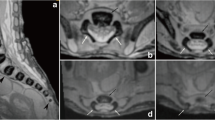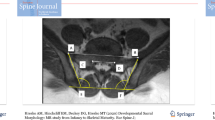Abstract
Many believe that the fetus spine had only one curvature from cranial to caudal which is a global kyphosis and that the lumbosacral lordosis appears with the erect posture. They agree that the sacrum of Homo sapiens is not positioned posteriorly at birth and that it is during the first few years that the sacrum, in humans, moves dorsally in relation with the progressive acquisition of erect posture and the ontogeny of bipedal locomotion. Nevertheless, there is no biometric study assessing these parameters in vivo in utero during the fetal life. Cross-sectional biometric study of the lumbosacral junction of the spine in in utero fetuses was to document the presence of a lumbosacral lordosis in the fetal population in utero long before standing and walking and its change during growth. Forty-five MRIs (magnetic resonance imaging) of fetuses aged of 23–40 weeks of gestation were analyzed. The measurements were performed on computerized MRI DICOM images using a professional software to calculate the curvature and radius of the lumbosacral junction. The presence or absence of visual lumbosacral lordosis was noted for each case. Correlation tests were performed in order to disclose a correlation between the gestational age and the curvature calculated. A test was considered significant for P < 0.01. There were 14 males, 17 females and 14 undetermined. All the curves (100%) showed mathematically the presence of a lordosis in the lumbosacral region. The visual lumbosacral lordosis was present in 60% of cases. The measurement of the lumbosacral curvature varies between −0.133 and −0.033 mm−1 and a mean of −0.054 mm−1 with a corresponding radius ranging from −7 to −303 mm with a mean of −18.7 mm. The statistical analysis showed no correlation between the gestational age and the lumbosacral curvature (R 2 = 0.11). The hypothesis of increased lumbosacral lordosis with gestational age is rejected. It is difficult to accurately determine the role played separately by genetics and by erect posture. A visual lumbosacral lordosis was noted in 60% of cases with mean radius of −18.6691 mm. This lordosis was not correlated statistically to gestational age which means that it is not related to growth and might be genetically determined. Mechanical factors may play a major role in the determination of the shape of the growing pelvis. One can ask if the pelvis morphology is genetically determined or if it is mechanically determined under muscular and ligamentous stresses. This study shows that the sacrum of human fetuses is oriented posteriorly mathematically in 100% of cases, and in 60% of cases based on the morphologic appearance of the lumbosacral junction. So beside the effect of progressive acquisition of erect posture and bipedalism in determining the formation of lumbosacral angle, we believe that genetics play an important role in the formation of the lumbosacral angle.










Similar content being viewed by others
References
Abitbol MM (1987) Evolution of the lumbosacral angle. Am J Phys Anthropol 72:361–372. doi:10.1002/ajpa.1330720309
Bagnall KM, Harris PF, James RM (1977) A radiographic study of the human fetal spine. 2. The sequence of development of ossification centers in the vertebral column. J Anat 124:791
Descamps H, Commare-Nordmann MC, Marty C et al (1999) Modification of pelvic angle during the human growth. Biom Hum Anthropol 17:59–63 in French
Dimeglio A, Bonnel F (1990) Le rachis en croissance. Springer, Paris
Duval-Beaupère G, Schimdt C, Cosson P (1992) A barycentremetric study of the sagittal shape of spine and pelvis: the conditions required for an economic standing position. Ann Biomed Eng 20:451–462. doi:10.1007/BF02368136
Flecker H (1942) Time of appearance and fusion of ossification centers as observed by roentgenographic methods. AJR Am J Roentgenol 47:97
Glard Y, Jouve JL, Garron E et al (2005) Anatomic study of femoral patellar groove in fetus. J Pediatr Orthop 25:305–308. doi:10.1097/01.bpo.0000161099.46339.eb
Glenn OA, Barkovich J (2006) Magnetic resonance imaging of the fetal brain and spine: an increasingly important tool in prenatal diagnosis: part 1. AJNR Am J Neuroradiol 27(8):1604–1611
Glenn OA, Barkovich J (2006) Magnetic resonance imaging of the fetal brain and spine: an increasingly important tool in prenatal diagnosis: part 2. AJNR Am J Neuroradiol 27(9):1807–1814
Griffiths PD, Widjaja E, Paley MN, Whitby EH (2006) Imaging the fetal spine using in utero MR: diagnostic accuracy and impact on management. Pediatr Radiol 36(9):927–933
Jackson RP, Hales C (2000) Congruent spinopelvic alignment on standing lateral radiographs of adult volunteers. Spine 25:2808–2815. doi:10.1097/00007632-200011010-00014
Jouve JL, Glard Y, Garron E et al (2005) Anatomical study of the proximal femur in the fetus. J Pediatr Orthop B 14:105–110
Kanal E, Borgstede JP, Barkovich AJ et al (2002) American College of Radiology white paper on MR safety. AJR Am J Roentgenol 178:1335–1347
Legaye J, Duval-Beaupère G, Hecquet J et al (1998) Pelvic incidence: a fundamental pelvic parameter for three-dimensional regulation of spinal sagittal curves. Eur Spine J 7:99–103. doi:10.1007/s005860050038
Legaye J, Hecquet J, Marty C et al (1993) Sagittal equilibration of the spine: relationship between pelvis and sagittal spinal curves in the standing position. Rachis 5:215–226
Louis ML, Jouve JL, Adalian P, Pomero V, Glard Y (2009) Fetal spine and pelvic incidence growth: biometric analysis (in press)
Mac-Thiong JM, Berthonnaud E, Dimar JR, Betz RR, Labelle H (2004) Sagittal alignment of the spine and pelvis during growth. Spine 29(15):1642–1647
Mangione P, Gomez D, Senegas J (1997) Study of the course of the incidence angle during growth. Eur Spine J 6:163–167. doi:10.1007/BF01301430
Mangione P, Sénégas J (1997) Normal and pathologic sagittal balance of the spine and pelvis. Rev Chir Orthop Repar Appar Mot 83:22–32
Marty C, Boisaubert B, Descamps H et al (2002) The sagittal anatomy of the sacrum among young adults, infants, and spondylolisthesis patients. Eur Spine J 11:119–125. doi:10.1007/s00586-001-0349-7
O’Rahilly R, Meyer DB (1956) Roentgenographic investigation of the human skeleton during early fetal life. AJR Am J Roentgenol 76:455
Rajnics P, Pomero V, Templier A et al (2001) Computer-assisted assessment of spinal sagittal plane radiographs. J Spinal Disord 14:135–142. doi:10.1097/00002517-200104000-00008
Schultz AH (1961) Vertebral column and thorax. Primatologica, 4. Liefer 5:1–66
Simon EM (2004) MRI of the fetal spine. Pediatr Radiol 34:712–719. doi:10.1007/s00247-004-1245-1
Vaz G, Roussouly P, Berthonnaud E et al (2002) Sagittal morphology and equilibrium of pelvis and spine. Eur Spine J 11:80–87. doi:10.1007/s005860000224
Widjaja E, Whitbi EH, Paley MNJ, Griffiths PD (2006) Normal fetal lumbar spine on postmortem MR imaging. AJNR Am J Neuroradiol 27:553–559
Conflict of interest statement
None of the authors has any potential conflict of interest.
Author information
Authors and Affiliations
Corresponding author
Rights and permissions
About this article
Cite this article
Choufani, E., Jouve, JL., Pomero, V. et al. Lumbosacral lordosis in fetal spine: genetic or mechanic parameter. Eur Spine J 18, 1342–1348 (2009). https://doi.org/10.1007/s00586-009-1012-y
Received:
Revised:
Accepted:
Published:
Issue Date:
DOI: https://doi.org/10.1007/s00586-009-1012-y




